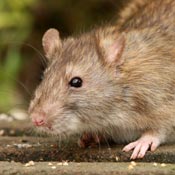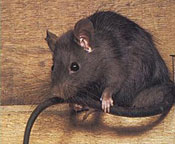Rats are a risk to health
The presence of rats is a serious health and safety concern. A rat-free environment is also a legal hygiene requirement for businesses (Health and Safety at Work Act (1974) and Food Safety Act (1990)). Their urine can harbour Leptospirosis bacteria, amongst an array of other diseases, causing Weil’s disease in man. The illness caused by this bacterium can be fatally serious!
The presence of rats in hospitality and food related industries will cause loss of reputation, goodwill and revenue, in addition to the possibility of prosecutions and closure. Signs or any problems with preventative rat control measures are likely to have have a negative impact on “scores on the doors” food hygiene ratings.
They can also cause structural damage, such as to the fabric of buildings and electrical wiring. This poses a serious fire hazard, which alone is reason enough to get rid of rats.
Brown (sewer) rat biology

Brown rat “Rattus norvegicus”
The brow rat weights between 200-500 grams with a heavy body, a tail shorter than its body and small ears. They live in damp conditions and were water is present including river banks and streams. Examples of rat activity, such as burrows can be readily observed along the banks of the Leeds-Liverpool canal and the river Douglas flowing through Wigan.
Brown rats are also found in sewers and outdoor animal housing. However they will readily move inside, especially during colder months. They can also be found in cellars and lofts.
The gestation period is 21 days and they can have up to 6 litters a year with up to 8 pinkies per litter. This means that a single pair, under favorable conditions, can produce up to 200 young a year! It is therefore important that action is taken at the first signs.
Brown rats should not be confused with Water voles (Arvicola terrestris) which are smaller, have rounded noses and shorter tails. This species is protected under the Wildlife and Countryside Act 1981. We always check for the presence of water voles near waterways before rat control commences.
All rat species use urine as a means of communication. One sign of a heavy infestation is the presence of urine trails: Grey-brown streaks where rats travel, 1-2 cm long sausage shaped droppings and a distinct ammonia-like odour caused by the breakdown of urine.
The black (ship) rat

Black rat “Rattus rattus”
The black rat is now relatively rare. It is mainly associated with ports and ships or present in lofts. I have personally not seen any in Wigan, Bolton, Preston or Liverpool. Black rats are more slender than the brown counterpart, with the tail longer than the body, relatively large ears and eyes. They are also excellent climbers. This species is associated with dry sheltered areas and is rarely found in sewers. It probably originated in South-East Asia. Black rats were probably a carrier of the rat flea, responsible for outbreaks of the bubonic plague in the middle ages.
Rat control in Wigan, Bolton, Preston, Liverpool and Manchester
Effectively eradicating rats starts with locating of droppings, identifying harbourage sites and identifying entry points for proofing. Food sources need to be removed or made inaccessible. Sewers are often points of entry, and these might need an internal inspection to detect defects. We always keep health and safety and the environment in mind and use sturdy, anchored, inaccessible bait boxes when carrying out rat baiting with rodenticides.
The environment usually dictates the type of bait and the active ingredient used. Rats are naturally shy of new objects: It might therefore take a week before they take baits. Alternative control methods include break back trapping and glue boards. These are generally not as effective, especially if the infestation is substantial. Finally, carcasses are frequently traced and removed to prevent secondary poisoning.
Rat elimination services are rated 4.9/5 based on 14 reviews.
